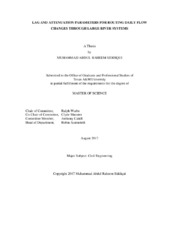| dc.description.abstract | The 2007 Senate Bill 3 (SB3) initiated the establishment of environmental flow standards and the incorporation of them in the Water Availability Modeling System (WAM) of Texas. This led to the creation of Water Rights Analysis Package (WRAP) daily modeling capabilities. The effects of water use and management actions propagate downstream to other locations of interest in water availability modeling over periods ranging from several hours to several days. Hence unlike the WRAP Monthly Simulation Model (SIM), the Daily Simulation Model (SIMD) includes routing of the effects of flow change events to downstream control points.
The previously developed six case study daily WAMs use routing parameters estimated through calibration using hydrographs at upstream and downstream ends of a river reach with computations performed with a genetic search algorithm. In this research, two new methods have been developed to estimate routing parameters.
1. Wave Travel Velocity Equation: Motivated by Manning’s equation and National Resources Conservation Service (NRCS) lag time equation. This equation calculates lag time based on flow, slope, and length of the reach.
2. DFLOW program: This program calculates the lag time between upstream and downstream control points for different flow change events in a time series record, and provide statistical measures of the results.
The wave travel velocity equation was applied to different reaches of the Brazos River and its tributaries and the DFLOW program was applied to the Neches, Brazos, and Trinity River Basins. Comparative analysis of different sets of routing parameters shows that lag times from the optimization-based parameters are unrealistically low for the Brazos and Neches River Basins. Lag times from DFLOW and the wave travel velocity equation are higher than optimization-based lag times and are more realistic when compared to typical average stream velocities.
Simulation results using different simulation options and routing parameters were compared to gauge the sensitivity of simulation results to different routing and forecasting options. Simulation results are sensitive to different routing parameters and routing and forecasting options but do not vary dramatically for any of these options. | en |


